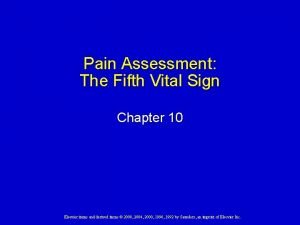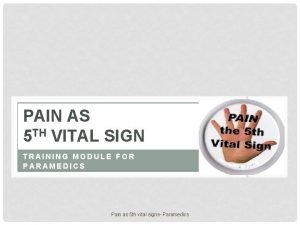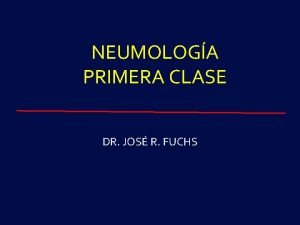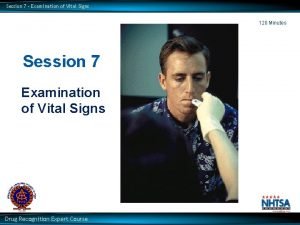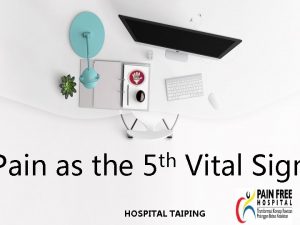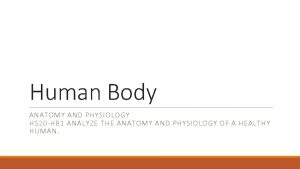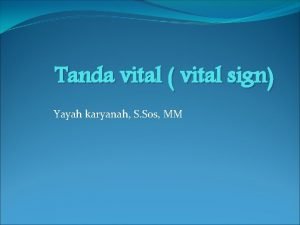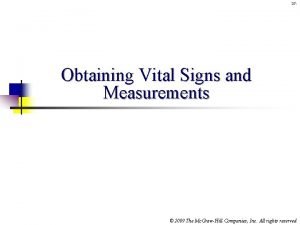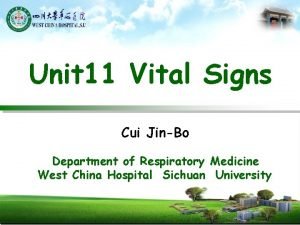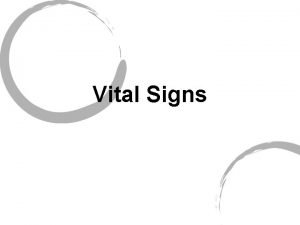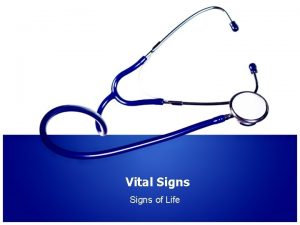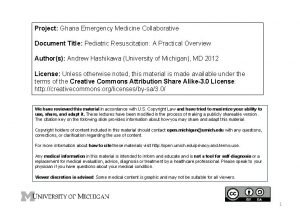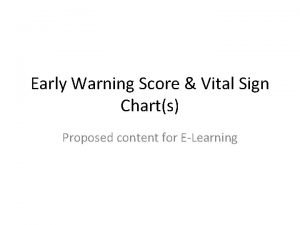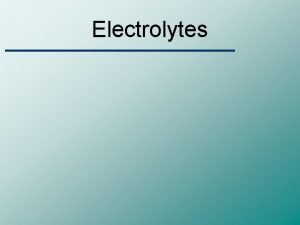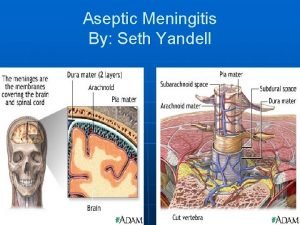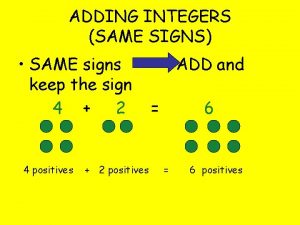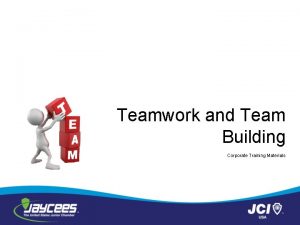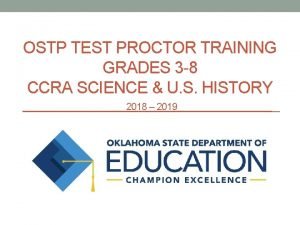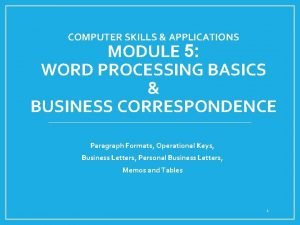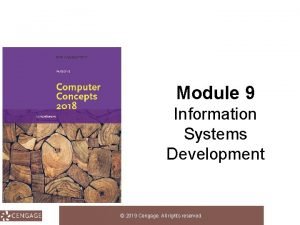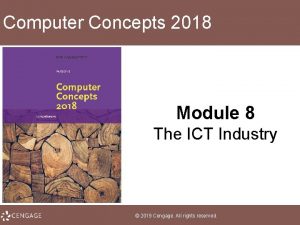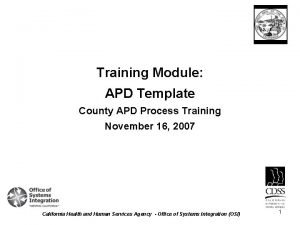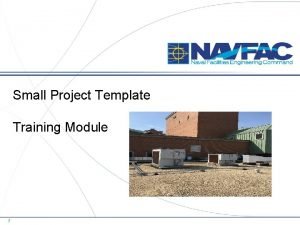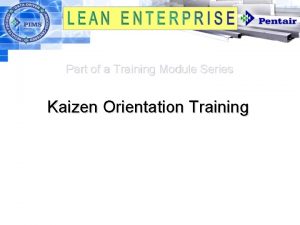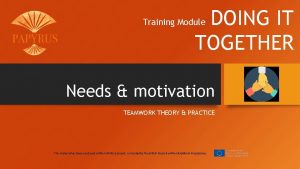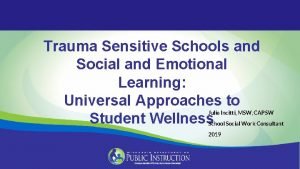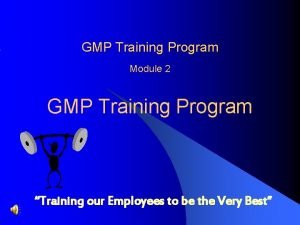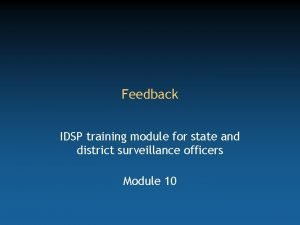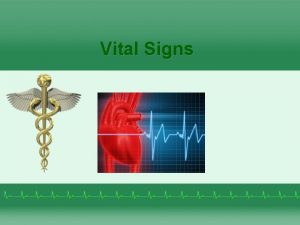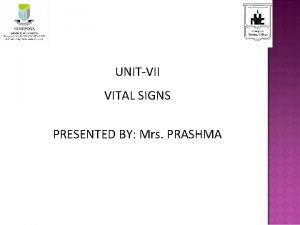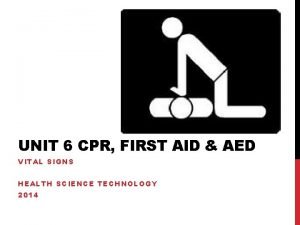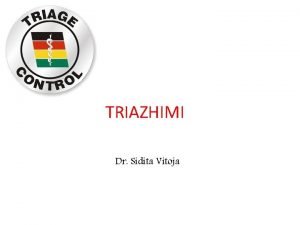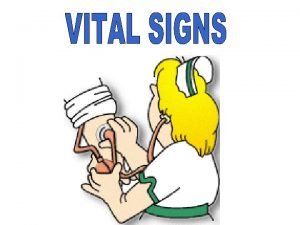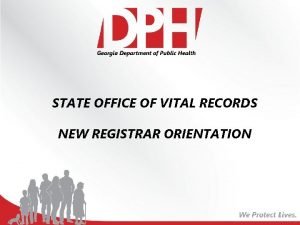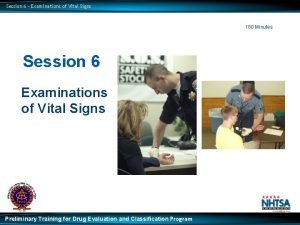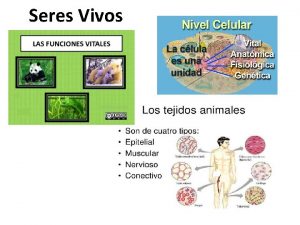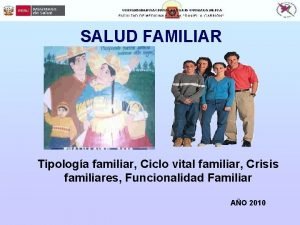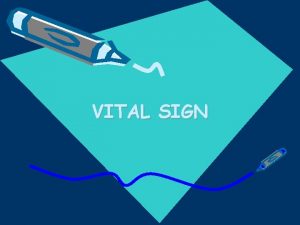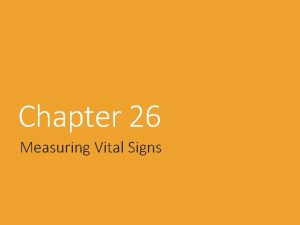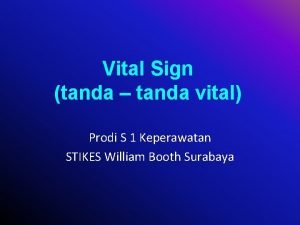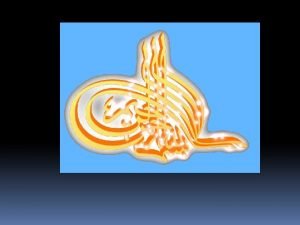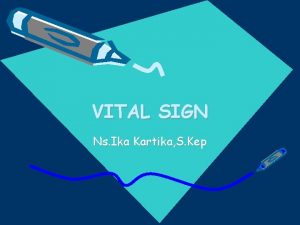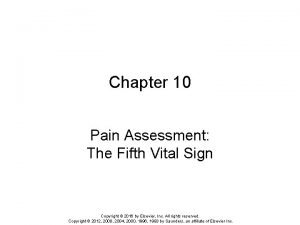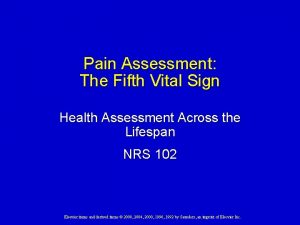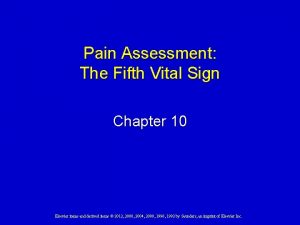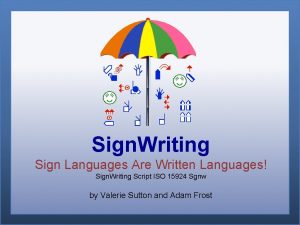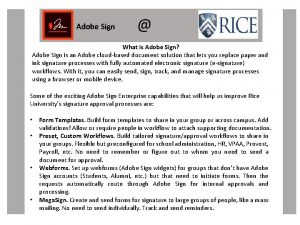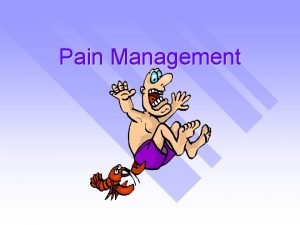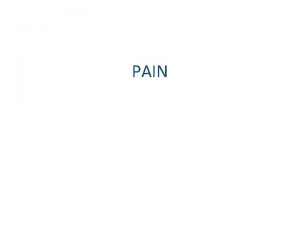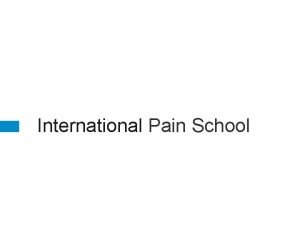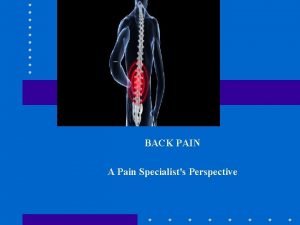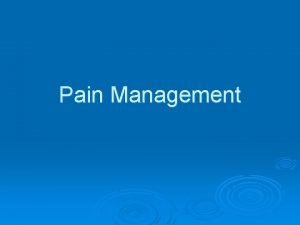PAIN AS 5 TH VITAL SIGN TRAINING MODULE






























































- Slides: 62

PAIN AS 5 TH VITAL SIGN TRAINING MODULE FOR PARAMEDICS Pain as 5 th vital signs- Paramedics

PEKELILING KPK BIL 9/2008 • Mandatory to carry out Pain as 5 th Vital sign • To provide routine assessment, treatment and documentation of pain score Pain as 5 th vital signs- Paramedics

CRITERIA FOR PAIN FREE HOSPITALS: Does your hospital… 1. Have a written policy on pain assessment and management? 2. Implement Pain as the 5 th Vital Sign? 3. Have standardized treatment protocols for management of acute pain? 4. Train all healthcare staff on knowledge and skills in pain assessment and management? 5. Educate patients and get them actively involved in their own pain management? 6. Carry out regular audit of pain assessment and management practices and outcomes? 7. Have a policy and guidelines on Minimally invasive surgery? 8. Have a policy and guidelines on Day Care Surgery? 9. Use a multidisciplinary team approach in pain management? 10. Incorporate non-pharmacological including T/CM into pain management practices? Pain as 5 th vital signs- Paramedics

TRAINING OBJECTIVES: • To improve understanding of pain • To teach simple framework of pain assessment and pain management • To reduce barriers to pain management • To meet objectives of Pain Free Hospital (PFH) concept Pain as 5 th vital signs- Paramedics

DEFINITION OF PAIN • Pain is an unpleasant sensory and emotional experience associated with actual or potential tissue damage or described in terms of such. (International Association for the Study of Pain, 1996) • Sensory component • Physical aspect of pain • Emotional component • Tolerance to pain • Depression • Anxiety Pain as 5 th vital signs- Paramedics

DEFINITION OF PAIN To the patient • Pain is what the patient says ! t i Sak Pain as 5 th vital signs- Paramedics

Pain can affect… ANYONE Rich and poor Young and old Educated and illiterate Doctors and nurses Lay person Pain as 5 th vital signs- Paramedics

DIFFERENT TYPES OF PAIN DIFFERENT LOCATION Injection Neck pain Cancer Trauma Low back pain Post op pain Arthritis Labour Pain as 5 th vital signs- Paramedics

CLASSIFICATION OF PAIN Type Descriptions Acute Pain of recent onset/sudden onset Chronic Last for more than 3 months, cannot identify cause Pain persist even after wound is healed Cancer Progressive; many different cause May be a mixture of acute and chronic pain Non cancer Nociceptive /physiological pain Neuropathic/ pathological pain Acute or chronic Obvious tissue injury or illness Somatic = bones and tissues = well localized Visceral pain: abdomen, thoracic cavity Nature of pain: sharp or dull Nervous system damaged or abnormality; May not see tissue injury Nature of pain: shooting + numbness, pins and needles, not well localized Pain as 5 th vital signs- Paramedics

DIFFERENCES BETWEEN ACUTE AND CHRONIC PAIN Acute pain Chronic pain Onset & timing Sudden, short duration Resolves /disappears when tissue heals Insidious onset Pain persists despite tissue healing Signal Warning sign of actual or potential tissue damage Not a warning signal of damage False alarm Severity Correlates with amount of damage Severity not correlated with damage CNS involvement CNS intact- acute pain is a symptoms CNS may be dysfunctional- chronic pain is a disease Psychological effects Less, but unrelieved pain anxiety and sleeplessness (improves when pain is relieved) Often associate with depression, anger, fear, social withdrawal etc. Pain as 5 th vital signs- Paramedics

COMMON CAUSES ACUTE PAIN CHRONIC PAIN Trauma/fracture/Surgery Chronic headache Burns Chronic low back pain Arthritis Chronic abdominal pain Abscess Chronic pelvic pain Myocardial infarction Cancer pain Labour pain & child birth NEUROPATHIC PAIN Acute shingles Post herpetic neuralgia Post spinal cord injury Diabetic peripheral neuropathy Brachial plexus injury Post stroke pain Pain as 5 th vital signs- Paramedics

WHY PAIN AS 5 TH VITAL SIGN? Pain as 5 th vital signs- Paramedics

Respiratory rate 4 Temperature Pulse rate Blood pressure Pain as 5 th vital signs- Paramedics

4 VITAL SIGNS- ARE THEY ADEQUATE? In the past: zero communication He is quiet and comfortable. BP, PR, RR are normal. He has no fever. Pain as 5 th vital signs- Paramedics I expect them to know that I am in severe pain

BENEFITS OF OF PAIN AS 5 TH VITAL SIGN • • • To patient, family and organization To provide holistic patient care To evaluate pain level accurately To give effective treatment To promote early ambulation To reduce post operative complications Pain as 5 th vital signs- Paramedics

BENEFITS OF PAIN AS 5 TH VITAL SIGN • Enhance healing, reduce length of stay • Reduce health care cost • Promote staff- patient interaction • Promote client satisfaction • Improve QOL, sleep, appetite • Reduce psychological distress Pain as 5 th vital signs- Paramedics

PAIN ASSESSMENT • Patients are the experts to give their pain score • Patient’s self report is the most reliable indication of the presence and intensity of pain • The nurse is not a mind reader to read patient’s pain Pain as 5 th vital signs- Paramedics

WHY PAIN ASSESSMENT? • To establish baseline of patient’s pain • To enhance patient’s comfort and satisfaction • Reduce complications • Shorten stay in ward • Enable titration of analgesia to achieve the best analgesia with least side effects • To reduce incidence and severity of pain • For research and documentation Pain as 5 th vital signs- Paramedics

WHEN SHOULD PAIN ASSESSED? • At regular interval- as the 5 th vital sign • • during routine observation of BP, HR, RR and temperature 4 hrly, 6 hrly or 8 hrly On admission of patient On transfer – in of patient • At other times apart from scheduled observations: • 1/2 to 1 hr after administration of analgesics and nursing • During and after any painful procedure in the ward e. g. wound dressing • Whenever the patient complains of pain Pain as 5 th vital signs- Paramedics

WHERE IS PAIN ASSESSMENT DONE? WARDS CLINICS OPERATING ROOMS CRITICAL CARE AREAS EVERYWHERE Pain as 5 th vital signs- Paramedics

WHO DOES PAIN ASSESSMENT? NURSES DOCTORS STUDENTS: MEDICAL & NURSING MEDICAL ASSISTANTS PHYSIOTHERAPISTS OCCUPATIONAL THERAPISTS EVERYONE! Pain as 5 th vital signs- Paramedics

Everywhere… everyone… Pain as 5 th vital signs- Paramedics

PAIN ASSESSMENT TOOL WHICH TOOL TO USE? HOW TO USE? Pain as 5 th vital signs- Paramedics

WHICH TOOL TO USE • Use the standard tool for pain assessment as recommended by the Ministry of health, M’sia • For adult patients: • use the MOH pain scale • For paediatric patients: • 1 month- 3 yrs : • 3 -7 years old: • >7 years: FLACC scale WONG BAKER FACES scale MOH pain scale • Always use the same tool for each patient Pain as 5 th vital signs- Paramedics

MOH PAIN SCALE On a scale of ‘ 0’-’ 10’ (show the pain scale) if ‘ 0’ = no pain and ‘ 10’= worst pain you can imagine, what is your pain score now? Patient is asked to slide the indicator along the scale to show the severity of his/her pain, which is recorded as a number (0 to 10) Pain as 5 th vital signs- Paramedics

FLACC SCORE • Observational tool for pain assessment • Indications: • For paediatric patients (1 month-3 years) • Elderly patient • Cognitively impaired patient • How to perform FLACC score: • • Observe for 2 -5 minutes Observe patient’s behavious Select score according to behaviour Add the acores to get the totoal score Pain as 5 th vital signs- Paramedics

FLACC SCALE Score Category 0 1 2 F ace No particular expression or smile Occasional grimace or frown, withdrawn, disinterested Frequent to constant quivering chin, clenched jaw L egs Normal position or relaxed Uneasy, restless, tense Kicking or legs drawn up A ctivity Lying quietly, normal position, moves easily Squirming, shifting back and forth, tense Arched, rigid or jerking C ry No cry (awake or asleep) Moans or whimpers; occasional complaint Crying steadily, screams or sobs, frequent complaints C onsolability Content, relaxed Reassured by occasional touching, hugging or being talked to distractible Pain as 5 th vital signs- Paramedics

FACES SCALES ( FOR 3 -7 YEARS) The Wong –Baker faces scale ( adapted from Wong DL et al, eds. Whaley and Wong’s essential of pediatric nursing. 5 th ed. St Louis, MO: Mosby, 2001) Pain as 5 th vital signs- Paramedics

WONG BAKER FACES SCALE • This is a self report tool consisting of 6 cartoon faces • Ask the child to choose a face which best describe his/her pain • Multiply the score below the face by 2 to get a maximum score of 10 • Be careful as some children might confuse the faces as a measure of happiness Pain as 5 th vital signs- Paramedics

HOW TO ASSESS PAIN • Important to: listen and believe the patient • Take a pain history: “Tell me about your pain…… Pain as 5 th vital signs- Paramedics

LANGUAGE / COMMUNICATION Ooops. . Foreigner? ! How to do pain score? I can’t speak his language. Pain as 5 th vital signs- Paramedics

HOW TO DO PAIN ASSESSMENT • Greet patient/ salam • Inform the purpose: • To get the patient’s correct pain score for proper treatment • Show and teach patient pain assessment tool • If ‘ 0’ ( smiling face) – no pain • ‘ 10’ ( crying face)- worst pain imaginable • What is your pain score now? Pain as 5 th vital signs- Paramedics

TAKING PAIN HISTORY 1. Ask the patient Listen and believe the patient who complains of pain. Pain history is taken using the acronym: P: place or site of pain A: aggravating factor (what makes the pain worse? ) I: intensity (pain score) N: nature and neutralizing factors (what makes the pain less? ) 2. In the first assessment you should: Mark the pain sites(s), pain score and nature of pain in the body chart Pain as 5 th vital signs- Paramedics

UNABLE TO ASSESS 3. Subsequent observations Only pain scores are taken and recorded in the pain assessment chart Record “Unable to score” for • • Unconscious patients Sedated patients Pain as 5 th vital signs- Paramedics

Flow Chart Pain the 5 th Vital Sign * PCM # only for opioids # * Maximum dose of paracetamol 4 gm/day (4 x 1 gm) Pain as 5 th vital signs- Paramedics

NURSING OBSERVATION CHART (VITAL SIGNS CHART) PS. KKM 1/2014 Patient’s Name : Age : Ward : DATE TIME Pain Score BP PR RR T°C Pain as 5 th vital signs- Paramedics PS NURSING INTERVENTION

What Will Happen When Pain Is Not Treated Properly ? Pain as 5 th vital signs- Paramedics

ADVERSE EFFECTS OF UNTREATED ACUTE PAIN System Effects Cardiovascular system HR, BP, O 2 demand, risk of MI Respiratory system Alveolar ventilation, pneumonia Gastrointestinal system Motility vomiting, ileus Musculoskeletal Immobility Immune function Personal Poor sleep, appetite, self esteem, weight loss depression, social deprivation, affects ADL/QOL Economic Natural immunity burden – going for treatment, financial stress Pain as 5 th vital signs- Paramedics

APPROACH TO PAIN Recognize Assess Treat Pain as 5 th vital signs- Paramedics

APPROACH TO PAIN MANAGEMENT R- RECOGNIZE • Does the patient have pain? • Do other people know the patient has pain? • Do YOU know the patient has pain? Pain as 5 th vital signs- Paramedics

IN PATIENT WHO IS UNABLE TO REPORT PAIN • Recognize pain in the cognitively impaired/non verbal patient/patient who don’t tell or cannot tell • Assess behaviors that may indicate pain: • • Facial grimaces Guarding, hitting, motioning for assistance Sighing Restlessness, tension anxiety, rubbing Decreased appetite Negative or repetitive vocalizations Insomnia Sadness or drying Pain as 5 th vital signs- Paramedics

APPROACH TO MANAGEMENT: A- ASSESS • How severe is the pain? (Pain score) • What type of pain is it? (Acute/chronic) • Aggravating factors? • What relieves the pain? Pain as 5 th vital signs- Paramedics

APPROAC TO PAIN MANAGEMENT T-TREAT • What non pharmacological treatment can I use? • What pharmacological treatment can I use? Pain as 5 th vital signs- Paramedics

PAIN MANAGEMENT BY PARAMEDICS Pain as 5 th vital signs- Paramedics

NON DRUG TREATMENTS: • Physical: • RICE • Surgery • Acupuncture, massage, physiotherapy • Psychological • • Explanation Reassurance Counseling Patient and caregiver education and support Pain as 5 th vital signs- Paramedics

PHYSIOTHERAPY: Diaphragmatic breathing exercises • Place both hands over the diaphragm region • Ask patient to breathe through the nose and blow out through the mouth • At the same time, you can feel your hands follow the breathing movements of the diaphragm but not the tummy Pain as 5 th vital signs- Paramedics

NON PHARMACOLOGICAL STRATEGIES CORTEX FOCUSED Relaxation Music Relaxation Distraction Guided imagery Pain as 5 th vital signs- Paramedics Distraction Guided imagery

NON PHARMACOLOGICAL STRATEGIES CORTEX FOCUSED Ice Massage Acupuncture Physiotherapy Elevation Hydrotherapy Pain as 5 th vital signs- Paramedics

NON PHARMACOLOGICAL STRATEGIES PSYCHOLOGICAL APPROACHES Explanation : Now I know what is happening to me Counseling: am taken notice of I Pain as 5 th vital signs- Paramedics Reassurance: Everything is gonna be alright

OTHER NURSING ACTIONS: • Check possible causes of pain • Blocked urinary catheter/distended bladder • Swollen intravenous site/tissued • Uncomfortable lying position • Inform doctor if nursing action is not effective Pain as 5 th vital signs- Paramedics

PHARMACOLOGICAL METHODS TO RELIEVE PAIN Pain as 5 th vital signs- Paramedics

ANALGESIC LADDER Pain as 5 th vital signs- Paramedics

Analgesic Ladder for Acute Pain Management Pain as 5 th vital signs- Paramedics

ABCD OF PAIN MANAGEMENT PAIN ASSESSMENT, JACOX ET AL 1992 ABCD of PAIN ASSESSMENT A Ask patients pain level regularly Assess pain systematically B Believe patient pain level Believe patient family on pain relief methods C Choose pain control options appropriate for the patient D Deliver intervention timely, logically and coordinated E Empower patient and family in pain management Pain as 5 th vital signs- Paramedics

RECOMMENDATION FOR EFFECTIVE IMPLEMENTATION: 1. PATIENT EDUCATION • • • Importance of giving accurate pain score Correct use of the pain scale Inform the nurse or doctor when in pain Patient's right to adequate pain treatment Discharge plan 2. DOCTORS, NURSES AND ALLIED HEALTH PERSONNEL • Be positive • Make it a culture to implement pain as 5 th vital sign Pain as 5 th vital signs- Paramedics

RECOMMENDATIONS FOR EFFECTIVE IMPLEMENTATION OF P 5 VS 3. DO NOT THINK OF INCREASE WORKLOAD • Think of patient’s ‘s comfort and recovery 4. INVOLVE MATRONS, SISTERS • Constantly monitoring and supervision of their staff in the implementation 5. POSTING: involve clinical nurses and students in training 6. NURSING CURRICULUM: Training must start from nursing college 7. Always follow the pain as 5 th vital signs flow chart Pain as 5 th vital signs- Paramedics

Pain assessment & 10 ‘S’ Salam/greet Senyum/smile Sopan/well mannered Sensitif/sensitive Segera/immediately Sentuh/touch Segak/ professional Selia/supervise Semangat/motivated Selidik/study and audit Pain as 5 th vital signs- Paramedics

ROLE OF TRAINERS • Be a member of the PFH or P 5 VS committee at hospital level, headed by hospital director (pengarah) • Conduct training for all nursing and allied health staff weekly or fortnightly • Conduct orientation talk on P 5 VS & PFH for all new staff • Ward sisters carry out daily monitoring/spot checks on implementation in your own wards • Compile report for quality improvement for your hospital Pain as 5 th vital signs- Paramedics

CONCLUSIONS • Pain as the 5 th vital sign is necessary to ensure patients a pleasant and comfortable stay in the hospital • We must be very positive and implement pain assessment diligently • Pain 5 th Vital signs must be made a practice culture just as for the other 4 vital signs • Pain as 5 th vital sign is beneficial to patient, staffs and organizations Pain as 5 th vital signs- Paramedics

When pain is well managed…. Pain as 5 th vital signs- Paramedics

Pain as 5 th vital signs- Paramedics

Pain as 5 th vital signs- Paramedics
 Sign chapter 10
Sign chapter 10 Pain 5th vital sign kkm
Pain 5th vital sign kkm Divided highway begins sign
Divided highway begins sign Volúmenes pulmonares
Volúmenes pulmonares Pain x mad
Pain x mad Period cramps vs early pregnancy cramps
Period cramps vs early pregnancy cramps Pms vs pregnancy
Pms vs pregnancy Respiration as a vital sign
Respiration as a vital sign 5 tanda vital sign
5 tanda vital sign Normal vital signs for adults
Normal vital signs for adults Vital signs
Vital signs Flacc scale kkm
Flacc scale kkm Hunger vital sign
Hunger vital sign Vital signs normal range
Vital signs normal range Nama nama nadi
Nama nama nadi Body measurements and vital signs chapter 36
Body measurements and vital signs chapter 36 Orthostatic vital sign
Orthostatic vital sign Vital signs definition
Vital signs definition Vitals normal ranges
Vitals normal ranges Peds vital signs chart
Peds vital signs chart Pews chart 1-4
Pews chart 1-4 C device module module 1
C device module module 1 Hypocalcemia chvostek
Hypocalcemia chvostek Trusso sign
Trusso sign 2na + glucose + bun
2na + glucose + bun Brudinskis sign
Brudinskis sign When the signs are the same add and keep the sign
When the signs are the same add and keep the sign Team building training materials
Team building training materials Sbcc training module
Sbcc training module Ccra training
Ccra training Hbyc visit
Hbyc visit Word processing packages
Word processing packages Module 5 computer concepts exam answers
Module 5 computer concepts exam answers Module 11 computer concepts exam
Module 11 computer concepts exam 8 step.training model
8 step.training model Training module template
Training module template Training module template
Training module template Kaizen training module
Kaizen training module Amway.ca ditto
Amway.ca ditto Motivation training module
Motivation training module Mary fertakis training module
Mary fertakis training module Gmp training slides
Gmp training slides Idsp training module
Idsp training module Training is expensive without training it is more expensive
Training is expensive without training it is more expensive Perbedaan on the job training dan off the job training
Perbedaan on the job training dan off the job training Aggression replacement training facilitator training
Aggression replacement training facilitator training Vital+amine
Vital+amine Biostatistics and vital statistics
Biostatistics and vital statistics Normal level of vital signs
Normal level of vital signs Radial pulse normal range
Radial pulse normal range Temperature
Temperature What are the 8 vital signs?
What are the 8 vital signs? Baseline vital signs
Baseline vital signs Conclusion for vital signs
Conclusion for vital signs Vital signs cpr
Vital signs cpr Graphing tpr
Graphing tpr Forunkul
Forunkul Teoria de campo
Teoria de campo Why does blood pressure increase with age
Why does blood pressure increase with age Georgia vital records
Georgia vital records 6 vital signs
6 vital signs Lobulo parietal funcion
Lobulo parietal funcion Apgar familiar
Apgar familiar
